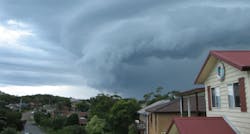Credit: Warrenlead, Creative Commons
Are low oil prices influencing decisions to include diesel generators in microgrids?
It’s a fair question to ask with fuel accounting for about 95 percent of the total cost of ownership of a diesel generator, and the gensets found in nearly 40 percent of new microgrids.
But fuel price doesn’t appear to play a big role in the decision to include diesel generators in microgrids, industry experts tell us.
For one, diesel prices are not declining in step with oil prices in most microgrid markets, said Peter Asmus, principal research analyst for Navigant Research.
Indeed, a review of U.S. oil and diesel prices, as reported by the Energy Information Administration, shows the spread narrowing in 2011, but then widening in 2012 and 2013, said Sheila Gailloreto, marketing director at Fairbanks Morse Engine, which specializes in ‘mission critical’ engines.
Supply and demand for diesel can heavily influence price. Demand for diesel tends to rise in the winter when it’s used for heating, or during periods of economic prosperity when the trucking industry uses more fuel. Last winter, North American truckers were aghast at the price of diesel at a time when oil prices were so low.
Further, petroleum prices are highly volatile. Microgrids are built to last decades. So any decisions about fuel price isn’t likely to be made based on short-term price trends.
Avoiding catastrophy
In any case, oil price is likely to be a secondary consideration when it comes to decisions to include diesel generators in U.S. microgrids.
Here’s why.
New grid-connected microgrids often have more than one fuel source, most commonly some combination of solar, wind, combined heat and power (CHP), energy storage and diesel. These microgrids are increasingly developed to shore up grid resiliency, to act as a safety valve when the grid goes down.
Because diesel microgrid generators can ramp up and down quickly, they are often the last line of defense before a power outage occurs.
Gailloreto describes their role as “avoidance of catastrophic failure.”
At that point — when a hospital, community, or military installation is about to lose power — the deciding factor is not fuel price; it’s keeping the lights on.
“Their role is to kick in on-grid, off-grid when needed, so the use of fuel is not so much of a factor,” Gailloreto said. “These diesel engines, I believe, will remain the key choice for load because of their response capability…the fast ramp-up capability.”
The downside of diesel generators is their high emissions. But diesel generators do not typically run continuously in a microgrid with multiple fuel sources; instead they are used in small increments. For example, in a renewable microgrid, the diesel generators might accommodate the intermittency of solar or wind power.
Because diesel is an established technology, microgrids are sometimes built around them. A city might already have diesel generators in place as back-up power, and then add more sophistication to the system with a microgrid controller and additional forms of generation and load.
What’s next
Credit: Fairbanks Morse Engine
Navigant Research found that diesel generators are used in about 38 percent of new microgrids, or 11 percent of global capacity. Diesel use is much larger when legacy microgrids are considerered, Asmus said.
There is a growing push to supplant diesel microgrids with cleaner fuels. Gailloreto envisions increasing use of dual fuel generators (diesel and natural gas). Such systems offer diesel’s fast ramp-up and a seamless switch to natural gas to reduce fuel costs and emissions. For example, Fairbanks Morse offers a dual fuel engine that is 1 percent diesel and 99 percent natural gas.
In any case, diesel — or biodiesel — is likely to be an important part of many community or resiliency-focused microgrids for some time to come.
“They are designed to be back-up generators. They are designed to run for 200 hours at most. If you really want truly 24/7 reliable power for a long time to come, they are going to be a very inexpensive way to get that redundancy,” said Darren Hammell, co-founder and chief strategy officer at Princeton Power Systems. “So I do think it will make sense to continue to have them as part of these [microgrid] systems. Otherwise you are adding so many batteries, or so much solar, the marginal costs becomes outrageous.”
Follow Microgrid Knowledge on twitter @MicrogridNews. Or sign up for the free Microgrid Knowledge Newsletter here.







